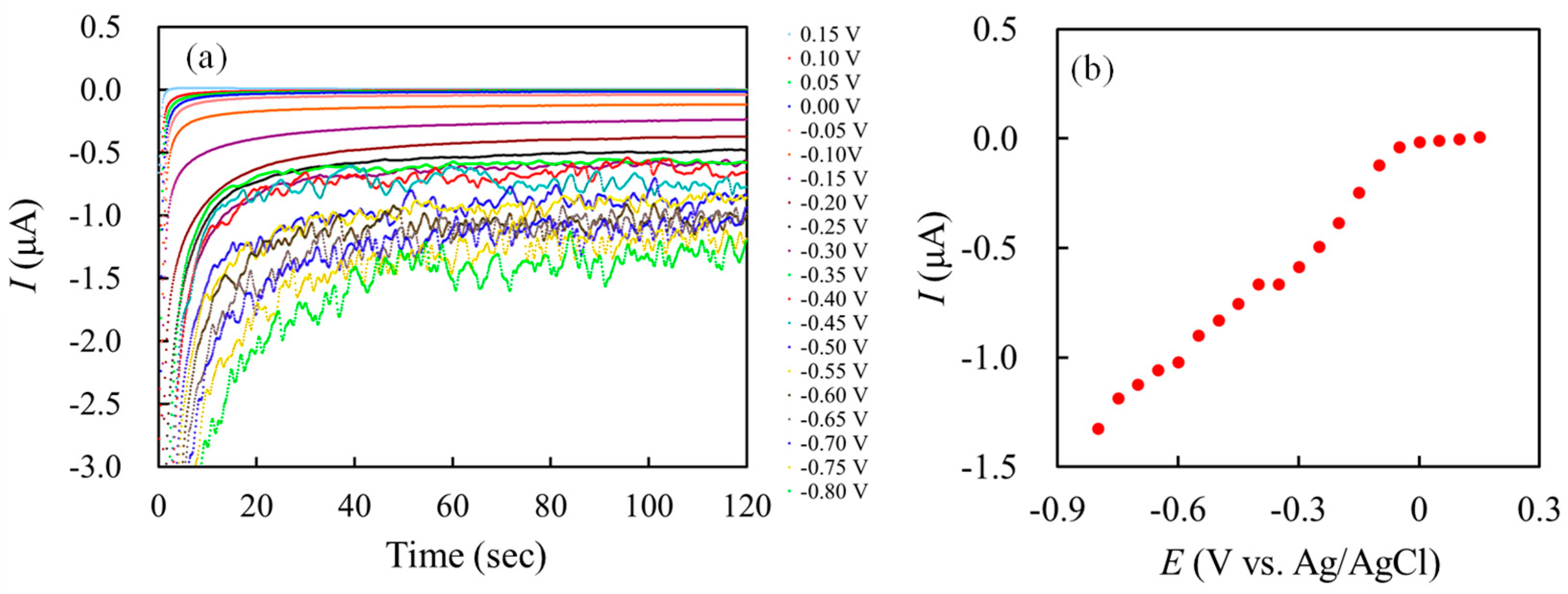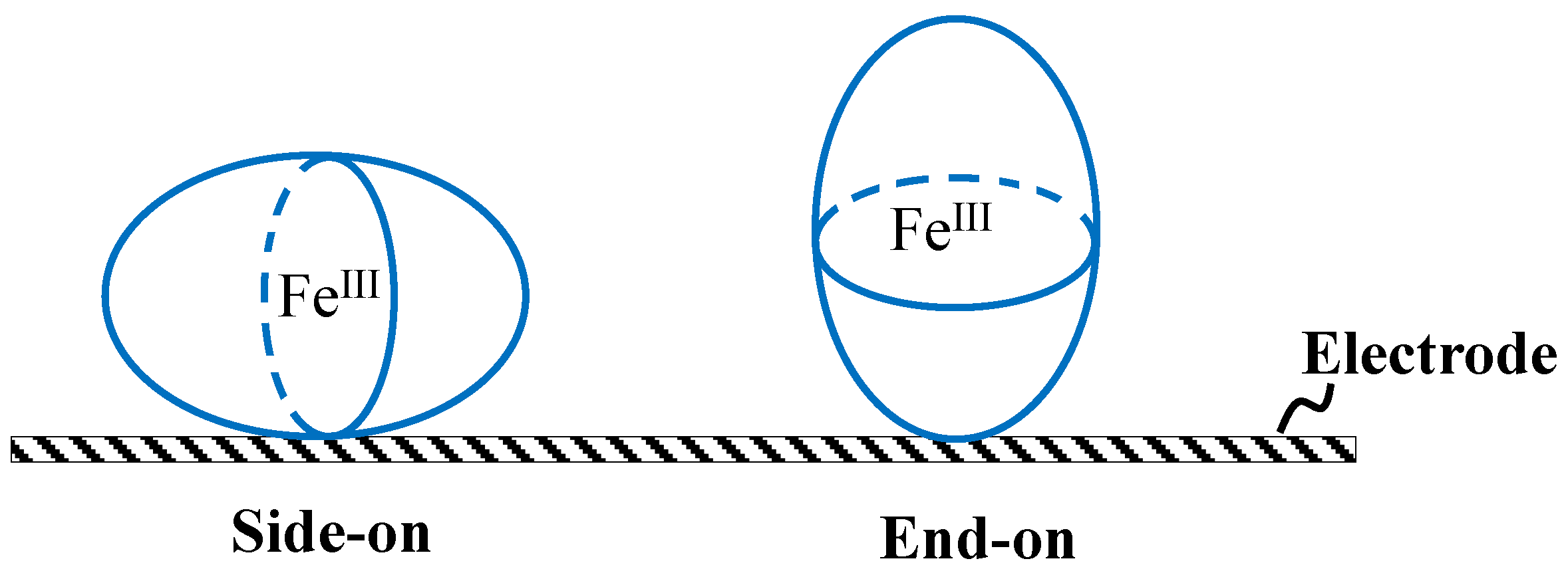Enhancement of Catalytic Efficiency of Enzymatic Redox Reactions by Composing Horseradish Peroxidase-Modified Electrode with Ionic Liquids
Abstract
:1. Introduction
2. Materials and Methods
2.1. Materials
2.2. Preparation of HRP-Modified Electrode
2.3. Instruments
3. Results
3.1. Chronoamperometric Response Performance at the HRP/CP-Modified Electrode under Applied Potential Control
3.2. Current Behavior of the HRP/CP/EC/MEMPTFSI-Modified Electrode by Injecting H2O2
3.3. Kinetic Behavior of the HRP/CP/EC/MEMPTFSI-Modified Electrode
4. Conclusions
Author Contributions
Funding
Data Availability Statement
Conflicts of Interest
References
- Heinzle, E.; Biwer, A.P.; Cooney, C.L. Development of Sustainable Bioprocesses, Modeling and Assessment; John Wiley & Sons, Ltd.: Chichester, UK, 2007. [Google Scholar]
- Buchholz, K.; Kasche, V.; Bornscheuer, U.T. Biocatalyst and Enzyme Technology, 2nd ed.; Wiley-Blackwell: Weinheim, Germany, 2012. [Google Scholar]
- Silwana, B.; Horst, C.V.D.; Iwuoha, E.; Somerset, V.; Environ, J. Amperometric determination of cadmium, lead, and mercury metal ions using a novel polymer immobilised horseradish peroxidase biosensor system. Sci. Health A Tox Hazard Subst. Environ. Eng. 2014, 49, 1501–1511. [Google Scholar] [CrossRef]
- Leech, D.; Kavanagh, P.; Schuhmann, W. Enzymatic fuel cells: Recent progress. Electrochim. Acta 2012, 84, 223–234. [Google Scholar] [CrossRef]
- Sheldon, R.A.; Woodley, J.M. Role of biocatalysis in sustainable chemistry. Chem. Rev. 2018, 118, 801–838. [Google Scholar] [CrossRef]
- Lopes, G.R.; Pinto, D.C.G.A.; Silva, A.M. Horseradish peroxidase (HRP) as a tool in green chemistry. RSC Adv. 2014, 4, 37244–37265. [Google Scholar] [CrossRef]
- Reda, T.; Plugge, C.M.; Abram, N.J.; Hirst, J. Reversible interconversion of carbon dioxide and formate by an electroactive enzyme. Proc. Natl. Acad. Sci. USA 2008, 105, 10654–10658. [Google Scholar] [CrossRef] [PubMed]
- Armstrong, F.A.; Hirst, J. Reversibility and efficiency in electrocatalytic energy conversion and lessons from enzymes. Proc. Natl. Acad. Sci. USA 2011, 108, 14049–14051. [Google Scholar] [CrossRef] [PubMed]
- Bassegoda, A.; Madden, C.; Wakerley, D.W.; Reisner, E.; Hirst, J. Reversible interconversion of CO2 and formate by a molybdenum containing formate dehydrogenase. J. Am. Chem. Soc. 2014, 136, 5473–15476. [Google Scholar] [CrossRef]
- Marpani, F.; Pinelo, M.; Meyer, A.S. Enzymatic conversion of CO2 to CH3OH via reverse dehydrogenase cascade biocatalysis: Quantitative comparison of efficiencies of immobilized enzyme systems. Biochem. Eng. J. 2017, 127, 217–228. [Google Scholar] [CrossRef]
- Sultana, S.; Sahoo, P.C.; Martha, S.; Parida, K. A review of harvesting clean fuels from enzymatic CO2 reduction. RSC Adv. 2016, 6, 44170–44194. [Google Scholar] [CrossRef]
- Rayalu, S.; Yadav, R.; Wanjari, S.; Prabhu, C.; Musthnoori, S.C.; Labhasetwar, N.; Satyanarayanan, T.; Kotwal, S.; Wate, S.R.; Hong, S.G.; et al. Nanobiocatalysts for carbon capture, sequestration and valorisation. Top Catal. 2012, 55, 1217–1230. [Google Scholar] [CrossRef]
- Ji, X.Y.; Su, Z.G.; Wang, P.; Ma, G.G.; Zhang, S.P. Tethering of nicotinamide adenine dinucleotide inside hollow nanofibers for high-yield synthesis of methanol from carbon dioxide catalyzed by coencapsulated multienzymes. ACS Nano 2015, 9, 4600–4610. [Google Scholar] [CrossRef] [PubMed]
- Addo, P.K.; Arechederra, R.L.; Waheed, A.; Shoemaker, J.D.; Sly, W.S.; Minteer, S.D. Methanol production via bioelectrocatalytic reduction of carbon dioxide: Role of carbonic anhydrase in improving electrode performance. Electrochem. Solid State Lett. 2011, 14, E9–E13. [Google Scholar] [CrossRef]
- Schlager, S.; Dibenedetto, A.; Aresta, M.; Apaydin, D.H.; Dumitru, L.M.; Neugebauer, H.; Sariciftci, N.S. Biocatalytic and bioelectrocatalytic approaches for the reduction of carbon dioxide using enzymes. Energy Technol. 2017, 5, 812–821. [Google Scholar] [CrossRef]
- Komori, K.; Tatsuma, T.; Sakai, Y. Direct electron transfer kinetics of peroxidase at edge plane sites of cup-stacked carbon nanofibers and their comparison with single walled carbon nanotubes. Langmuir 2016, 3, 9163–9170. [Google Scholar] [CrossRef] [PubMed]
- Zdarta, J.; Meyer, A.S.; Jesionowski, T.; Pinelo, M. A general overview of support materials for enzyme immobilization: Characteristics, properties, practical utility. Catalysts 2018, 8, 92. [Google Scholar] [CrossRef]
- Noritomi, H. Biochar: Characterization and Applications in Enzyme Technology; Generis Publishing: Durham, NC, USA, 2022; ISBN 979-8-88676-250-1. [Google Scholar]
- Kano, K.; Ikeda, T. Fundamentals and practices of mediated bioelectrocatalysis. Anal. Sci. 2000, 16, 1013–1021. [Google Scholar] [CrossRef]
- Wang, J.; Liu, J.; Cepra, G. Thermal stabilization of enzymes immobilized within carbon paste electrodes. Anal. Chem. 1997, 69, 3124–3127. [Google Scholar] [CrossRef] [PubMed]
- Noritomi, Y.; Kuboki, T.; Noritomi, H. Estimation of immobilized horseradish peroxidase in a low salt concentration for an irreversible electrochemical system. Results Chem. 2020, 2, 100055. [Google Scholar] [CrossRef]
- Taliene, V.R.; Ruzgas, T.; Razumas, V.; Kulys, J. Chronoamperometric and cyclic voltammetric study of carbon paste electrodes using ferricyanide and ferrocenemonocarboxylic acid. J. Electroanal. Chem. 1994, 372, 85–89. [Google Scholar] [CrossRef]
- Freire, R.S.; Pessoa, C.A.; Mello, L.D.; Kubota, L.T. Direct electron transfer: An approach for electrochemical biosensors with higher selectivity and sensitivity. J. Braz. Chem. Soc. 2003, 14, 230–243. [Google Scholar] [CrossRef]
- Yue, K.; Zhai, C.X.; Gu, S.N.; He, Y.Y.; Yeo, J.J.; Zhou, G.W. Performance-enhanced lithium metal batteries through ionic liquid based electrolytes and mechanism research derived by density functional theory calculation. Electrochim. Acta 2021, 368, 137535. [Google Scholar] [CrossRef]
- Hallett, J.P.; Welton, T. Room-temperature ionic liquids: Solvents for synthesis and catalysis. 2. Chem. Rev. 2011, 111, 3508–3576. [Google Scholar] [CrossRef] [PubMed]
- Itoh, T. Ionic liquids as tool to improve enzymatic organic synthesis. Chem. Rev. 2017, 117, 10567–10607. [Google Scholar] [CrossRef]
- Noritomi, H.; Nishida, S.; Kato, S. Protease-catalyzed esterification of amino acid in water-miscible ionic liquid. Biotechnol. Lett. 2007, 29, 1509–1512. [Google Scholar] [CrossRef] [PubMed]
- Noritomi, H.; Suzuki, K.; Kikuta, M.; Kato, S. Catalytic activity of α-chymotrypsin in enzymatic peptide synthesis in ionic liquids. Biochem. Eng. J. 2007, 47, 27–30. [Google Scholar] [CrossRef]
- Noritomi, H.; Minamisawa, K.; Kamiya, R.; Kato, S. Thermal stability of proteins in the presence of aprotic ionic liquids. J. Biomed. Sci. Eng. 2011, 4, 94–99. [Google Scholar] [CrossRef]
- Noritomi, H.; Chiba, H.; Kikuta, M.; Kato, S. How can aprotic ionic liquids affect enzymatic enantioselectivity. J. Biomed. Sci. Eng. 2013, 6, 954–959. [Google Scholar] [CrossRef]
- Noritomi, Y.; Kuboki, T.; Noritomi, H. Promotion of the redox reaction at horseradish peroxidase modified electrode combined with ionic liquids under irreversible electrochemical conditions. Results Chem. 2022, 4, 100666. [Google Scholar] [CrossRef]
- Bailey, J.E.; Ollis, D.F. Biochemical Engineering Fundamentals, 2nd ed.; McGraw-Hill: New York, NY, USA, 1986. [Google Scholar]
- Dunford, H.B.; Stillman, J.S. On the function and mechanism of action of peroxidases. Coord. Chem. Rev. 1976, 19, 187–251. [Google Scholar] [CrossRef]
- Das, D.; Dasgupta, A.; Das, P.K. Improved activity of horseradish peroxidase (HRP) in ‘specifically designed’ ionic liquid. Tetrahedron Lett. 2007, 48, 5635–5639. [Google Scholar] [CrossRef]
- Gajhede, M.; Schuller, D.J.; Henriksen, A.; Smith, A.T.; Poulos, T.L. Crystal structure of horseradish peroxidase C at 2.15 Å resolution. Nat. Struct. Biol. 1997, 4, 1032–1038. [Google Scholar] [CrossRef] [PubMed]
- Bekard, I.; Dunstan, D.E. Electric field induced changes in protein conformation. Soft Matter 2014, 10, 431–437. [Google Scholar] [CrossRef] [PubMed]
- Berglund, G.I.; Carlsson, G.H.; Smith, A.T.; Szöke, H.; Henriksen, A.; Hajdu, J. The catalytic pathway of horseradish peroxidase at high resolution. Nature 2002, 417, 463–468. [Google Scholar] [CrossRef]
- Bard, A.J.; Faulkner, L.R. Electrochemical Methods, Fundamentals and Applications, 2nd ed.; John Wiley & Sons, Inc.: New York, NY, USA, 2001; pp. 7+21. [Google Scholar]
- Ruzgas, T.; Csoregi, E.; Emneus, J.; Gorton, L.; Marko-Varga, G. Peroxidase-modified electrodes: Fundamentals and application. Anal. Chim. Acta 1996, 330, 123–138. [Google Scholar] [CrossRef]
- Fersht, A. Structure and Mechanism in Protein Science: A Guide to Enzyme Catalysis and Protein Folding; W. H. Freeman and Company: New York, NY, USA, 1999. [Google Scholar]




| Enzyme-Modified Electrode | KM (M) | Vmax (μM−1s−1) | kcat (s−1) | kcat/KM (M−1s−1) |
|---|---|---|---|---|
| HRP/CP-modified electrode | 0.09 | 0.50 | 0.06 | 0.67 |
| HRP/CP/EC/MEMPTFSI-modified electrode | 0.09 | 2.84 | 0.36 | 4.00 |
Disclaimer/Publisher’s Note: The statements, opinions and data contained in all publications are solely those of the individual author(s) and contributor(s) and not of MDPI and/or the editor(s). MDPI and/or the editor(s) disclaim responsibility for any injury to people or property resulting from any ideas, methods, instructions or products referred to in the content. |
© 2024 by the authors. Licensee MDPI, Basel, Switzerland. This article is an open access article distributed under the terms and conditions of the Creative Commons Attribution (CC BY) license (https://creativecommons.org/licenses/by/4.0/).
Share and Cite
Noritomi, Y.; Kuboki, T.; Noritomi, H. Enhancement of Catalytic Efficiency of Enzymatic Redox Reactions by Composing Horseradish Peroxidase-Modified Electrode with Ionic Liquids. Liquids 2024, 4, 393-401. https://doi.org/10.3390/liquids4020020
Noritomi Y, Kuboki T, Noritomi H. Enhancement of Catalytic Efficiency of Enzymatic Redox Reactions by Composing Horseradish Peroxidase-Modified Electrode with Ionic Liquids. Liquids. 2024; 4(2):393-401. https://doi.org/10.3390/liquids4020020
Chicago/Turabian StyleNoritomi, Yasuko, Takashi Kuboki, and Hidetaka Noritomi. 2024. "Enhancement of Catalytic Efficiency of Enzymatic Redox Reactions by Composing Horseradish Peroxidase-Modified Electrode with Ionic Liquids" Liquids 4, no. 2: 393-401. https://doi.org/10.3390/liquids4020020





